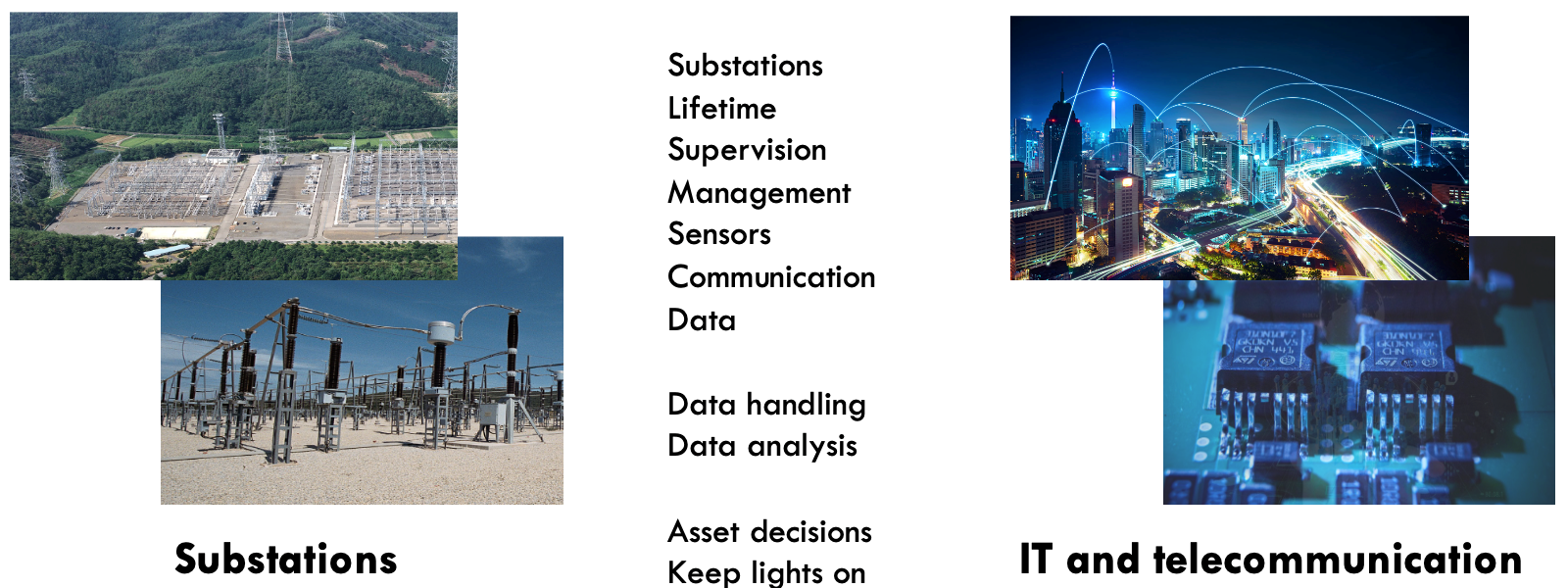Life-long Supervision and Management of Substations by use of Sensors, Mobile Devices, Information and Communication Technologies

Background
Substations are key elements in the present and future electricity networks, hosting a wide range of equipment and are responsible for providing key functions for proper grid operation and for “keeping lights on”. Their supervision and management are essential for the proper functioning of the electric network.
The equipment currently installed in such substations ranges from established aged equipment to equipment utilizing the latest digital and automation technologies. All those need continuous supervision and management, as well as efficient decision making over decades of their entire life.
While in large HV substations, the installation of permanent supervision/monitoring systems and sensors and use of advanced technologies is a small fraction of the asset cost, in distribution, especially in primary and secondary substations, this might be very different. In addition, due to the large number of such substations, distributed over large areas, obtaining life data from installed equipment, and keeping this data updated is presently costly.
Smart technologies including new intelligent sensors and monitoring systems, mobile devices, fast communications, and robotic devices can allow to collect a lot of real-time, life data at many locations at affordable cost.
The resulting large amount of alphanumeric and multimedia data, collected over the lifetime of substation equipment, needs proper data models, systematic management and validation, long time storage, easy retrieving for data processing. Lifetime data is a valuable source of information, for advanced mathematical algorithms, and for better asset management, maintenance, and operational decisions.
The changes in the electrical networks due to distributed energy resources, power electronics, weather events and the evolution of society, raise new challenges for substation equipment to manage and keep it at any time operational. The digitization and the evolution of power equipment itself with built in intelligence, sensors and communications can provide new ways to execute on-site activities and interaction with nearby humans or robotic devices, regarding status, history, events or required actions.
Advanced data processing technologies, Artificial Intelligence (AI) will and are already starting to impact management decisions.
Technologies such as Augmented Reality (AR) and Virtual Reality (VR) are enhancing work on site, training, and knowledge transfer.
The supervision and management of substations over their lifetime, needs a holistic view based on engineering background knowledge combined with, information, communication, and sensing technologies.
The JWG B3/D2.62 and topics envisaged by its Technical Brochure
The present Joint Working Group “Life-long Supervision and Management of Substations by use of Sensors, Mobile Devices, Information and Communication Technologies” continues and extends the work of a previous CIGRE WG B3.44, “Substation servicing and supervision using mobile devices and smart sensing”. The focus of the previous WG was mainly on technologies for large substations for servicing and using mobile technologies. The present JWG, is considering the needs of much more numerous smaller primary and secondary substations and is investigating aspects related to life-long supervision and management, needs for lifelong data collection, handling, processing, and decision support.
The goal of the JWG is to identify, starting from utility needs, the current and near-term usable technologies, methods, and applications using sensors, mobile devices, the Internet of Things (IoT) and information and communication technologies, data analysis and processing which can improve substation supervision and management over entire life of the substation equipment and improve or provide timely, situation aware and well-founded decision support for operation, maintenance and asset management.
The Joint Working Group is involving mainly members from Study Committee B3 “Substations and electrical installations”, and from study committee D2 “Information systems and telecommunication”, however input and contributions from other Study Committees will be considered.
The topics of interest for the Working Group require a holistic view of the substations and its operation over lifetime and the sensing, monitoring, and data application to handle all stakeholder needs in terms of operation, repair and maintenance and asset management.

Figure 1 - A holistic view of substation lifetime supervision and management involves substation engineering and data IT and communications
In Figure 1 the two sides are related to substation engineering, installed equipment and operational technologies and to the data, communication and processing IT technologies which need to be considered together. The most important linking element is lifetime data. The most useful support can be derived by combining data processing methods and substation and equipment engineering knowledge.
The relevant, accurate, reliable, and often complex multimedia data or time series from substation operation and events, from sensors and monitoring equipment, from inspection or diagnostic and maintenance activities, need to be collected over lifetime and cleaned, validated, processed, stored, and permanently analysed.
The JWG will consider the following aspects:
- Identify the utility needs regarding life-long supervision and management activities, for equipment in substations which can benefit from state-of-the-art sensors, intelligent devices and information and communication technologies (ICT). Short-term and mid-term needs for supervision, for enabling optimised management and on-site activities, for refurbishment, for prevention of human and environmental hazards, for staff training and support, and for use during normal and emergency situations, will be considered. A world-wide survey will attempt to identify the current situation, activities, trends, and strategies.
- Identify and review the present status and trends of sensors, intelligent devices, information and communication technologies and applications, usable for substation life-long supervision and management. Consider fixed or mobile sensor devices, sensor networks, sensors built-in or attached to substation equipment, and sensing by devices used or worn by humans, robots, or drones. Identify the evolution of sensors and intelligence build in power equipment and possible new interaction possibilities of this equipment with humans and robotic devices. Identify potential benefit and limitations.Take into consideration presently usable and mid-term expected technologies. Identify appropriate architecture(s) for collecting, processing, long-time storage and handling lifetime data, suitable for use with present and future sensing technologies.
- Identify and analyse life-long data related aspects for distribution substations and equipment, technologies and challenges and make recommendations. This will include: 1) How to effectively address equipment and substation many decades encompassing lifetime data, in a sustainable and systematic way, in the view of the existing and upcoming large amounts of data over the lifetime of equipment. Consider discrete life data, time series and multimedia data from: supervision, inspection, events, operation, maintenance, environmental conditions, catastrophic situations, failures etc., as collected by smart sensors or sensor networks, human inspections, human activities such as work on-site, collected by robots and drones, etc. 2) Consider and identify appropriate data models, consider long data storage aspects, data retrieval for processing and management, the possibility to have a digital equivalent or twin of installed equipment such that can handle relevant information, that can be aware on equipment’s own status and history, and which can possibly communicate with human and autonomous robotic devices. 3) Identify and recommend approaches and technologies suitable for the equipment lifetime data needs, which can be used immediately or available in the mid-term.
- Identify the current situation and applications using supervision, smart or mobile and ICT technologies used or tried world-wide for substations needs, including lessons learned, benefits or limitations.
- Conclude and issue recommendations for lifetime supervision and management of substations.
